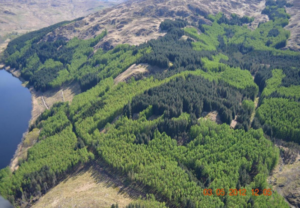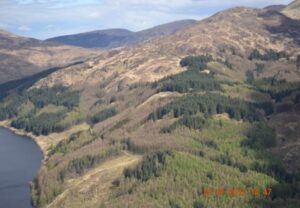Larch Disease and Statutory Plant Health Notices
19 December 2023Dead larch trees are becoming more common particularly in the west of Scotland where the climate is ideal for the disease. The disease that affects the trees is called Phytophthora ramorum and was first identified in Scotland in plant nurseries on Rhododendron in 2002. In 2010 it was first found on larch at a site on the Draiginish peninsular in western Scotland. In 2011 it had been detected on Mull and at several locations in Dumfries and Galloway.
Symptoms and Spread
P. ramorum causes needle loss, shoot dieback, bleeding cankers and death of trees. This can be rapid in one or two growing seasons. Photo A shows initial infection and Photo B shows infection one year later.
All three commercial larch species are affected. The disease spreads by spores that are produced on live infected larch Needles. These are then spread by rain, splash, mist and water movement to infect other larch trees. Long distance spread can occur in moist winds, movement of infected plant material and associated growing media and soil movement on people, vehicles and animals. The photos below show initial infection image A and infection one year later image B.

Photo A. (Image credit Scottish Forestry)

Photo B. (Image credit Scottish Forestry)
Surveying
Scotland is surveyed twice a year by helicopter in May/June and August/September. Around 1.3 million hectares are surveyed each year. Dead or dying trees are identified and the location is marked on the map for a field survey to be carried out. Once the infected tree is identified and felled a sample of infected material is used on a lateral flow test while another sample can be taken away for a laboratory confirmation test.
Statutory Plant Health Notice
Statutory Plant Health Notices (SPHN’s) are issued to indicate the need to fell all larch trees up to 250 metres of an infected tree within a given timeline. Accompanying the notice is a list of approved agents to support with the process. There is no requirement to restock (replant) the area of felled larch trees however felling is compulsory. If you don’t arrange for the trees to be felled then the work will be done for you and you will receive the bill for the work.
Zones
Scotland is split into three zones. Firstly, the management zone in the South West which was set up in 2013 where the disease is too advanced to stop and so the focus is on control outwith this area. No SPHN’s are awarded in this area. Secondly, there is the Risk Reduction Zone, set up in 2022. This gives landowners more time to fell trees covered under SPHN’s and geographically covers the West and Southwest around the management zone. The final zone is the Priority Action Zone. In this zone, the SPHN is issued quickly with felling occurring before August which is the time when spores are released.
Felling Permission
There is no need for a felling permission if you are felling only larch and a small percentage of other species to gain access to the larch.
Felling permission would be required if you decide to fell larch outwith the 250m buffer zone or if larch is mixed with other species and you decide to fell all trees.
Felling and Wood Movement Licences
Prior to felling, you should consult with agents to identify the options that you have and discuss with them what you would like to do before any decisions are made.
If you intend to move material from the location of SPHN then you are required to apply for a movement licence. The end user also requires a processing licence. Information on applying for a wood movement licence and the application forms can be found here.
Restocking
In the past, larch have tended to be planted on dry soils. With their limited branching and lack of needles you may not need to do any ground preparation for the subsequent trees and be able to direct plant.

The above photo is an example of an area of larch recently felled which could be direct planted.
As many of the species that you are required to plant for the restock grant are palatable to herbivores, some protection and/or control will likely be required to allow the tree to establish.
Conifers have to be planted at a minimum density of 2,500 nr per ha or 2 metre spacing. Broadleaves need to be planted at 1,600 nr per ha or 2.5 metre centres.
Species to avoid would be as follows:
- All larch species
- Douglas Fir
- Western Hemlock
- Sweet Chestnut
- Beech
- Ash
- Southern Beech
Grants
Please see below a summary of the most useful grants. The full list can be found at https://www.ruralpayments.org/topics/all-schemes/forestry-grant-scheme/tree-health/.
If you accept them, you will be required to restock (replant):
- Agent services – Harvesting & marketing = £1,000.
- Larch clearance first 5 ha = £1,200 per ha.
- Larch clearance 5 to 10 ha = £600 per ha.
- Larch clearance 10 ha plus = £300 per ha.
- Restocking = £1,400 per ha, Sitka Spruce is not allowed.
- Rhododendron clearance mechanical = £2,200 to £5,600 per ha.
Summary of Actions
If a Statutory Plant Health notice is served to you, follow the steps below:
- Contact an approved agent regarding what your felling options are and consult them before any decisions are made.
- As part of these discussions, establish if your approach to access the Larch trees requires a felling permission or not.
- Investigate if restocking would be in your interest and if so, would it be beneficial to apply for some grant support.
- If you opt to restock, seek specialist advice on the management of the restocking to make sure it establishes.
- If you are moving wood of site, ensure you have applied for a wood movement licence.
Related Materials
Sign up to the FAS newsletter
Receive updates on news, events and publications from Scotland’s Farm Advisory Service

